
Ile-de-France
Paris, "the city of light"![[Unesco]](/images/unesco-logo.gif)
![[+]](/images/icone-etoile.png)
The Celtic tribe of Parisii settled near Paris (probably in Nanterres) during the 3rd century B.C. From there, the city stretched to islands in the middle of the Seine river (such as île de la Cité or île Saint-Louis still existing today). After the conquest of Gaul by the Roman legions (58-52 B.C.), the city was then named Lutetia.
There is a legend about the first bishop of Paris who was beheaded in 280. This legend says that after being beheaded he picked up his head and walked for a while holding it in his hands.
The Patron Saint is St. Genevieve who is credited with saving the city by her prayers in 451 AD during the coming of the Huns led by Attila.
In 508, Clovis, the first king of the Franks made Paris the capital of his kingdom. Later on, Charlemagne established the capital in Aix-la-Chapelle. Although Paris became again several times the capital, it was only under Francis I in the sixteenth century that it remained capital permanently.
"Paris will always be Paris !". In fact, more than a capital, it has long been the image of France despite France is the union of several different regions. Paris is also "the city of love" or "Paname" in slang. It is also the city of fashion...
Paris is an union of several villages and so there is not just one Paris but several Paris. As a matter of fact, it is quite astounding to notice how the atmosphere can change from one neighborhood to another !
The right bank is located north of the Seine and the left bank, which is the place of living for students and middle classes, is in the south. The districts follows each other in a spiral line beginning in Ile de la Cité. A ring road surrounds Paris with many traffic jams. The "périphérique intérieur" is the inside of the ring road and goes clockwise whereas the "périphérique extérieur" is the other lane.
The Eiffel tower
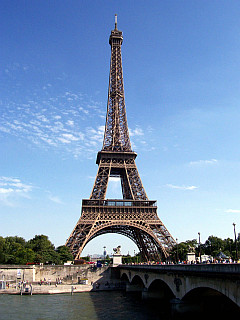
Also nicknamed "the iron Lady", it is the symbol of Paris and even France !
It was built by superimposition of steel structures from 1887 to 1889 under the guidance of the engineer Gustave Eiffel and, with its three floors, it reaches a height of 324 m (1,063 feet). It was the tallest tower in the world at the time of its construction and it remained so until 1931. The first floor (where there is a cinema showing a movie about the history of the Eiffel Tower) and the second floor (where there is a restaurant) can be reached either by stairs (there are 1665 steps) or by lift. The view over Paris is superb. And to think it was initially supposed to stand only for the Universal Exposition of 1889... It has been a good idea to keep it "a little" longer, hasn’t it ?
Near one of the pillars, we can see a bust of Eiffel.
Do not miss either taking a tour of Paris by boat. These cruise boats come from Lyon and appeared in the capital during the Exposition of 1867, so before the Eiffel Tower.
At the foot of the tower, there is the Champ de Mars (formerly a drill field, and now a park) and the military school (Napoleon spent a year there).
The Trocadero gardens and the Chaillot palace
The Chaillot palace, comprising of two curved wings, stands in front of the Eiffel Tower. It houses several museums and exhibitions. Its esplanade overlooks the Trocadero gardens and offers a nice overview.
Cathédrale Notre-Dame (Our Lady cathedral)
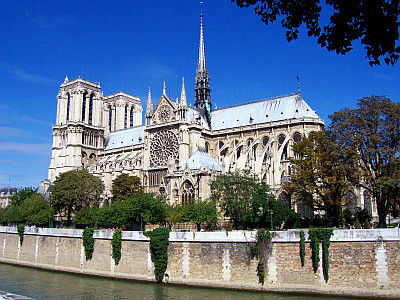
The Gothic cathedral was built from the twelfth to the fourteenth century on an island (Ile de la Cité) and is still today one of the finest monuments of Paris. Victor Hugo, famous french writter, immortalized it once again with his characters of Quasimodo (the bell-ringer, hunchback) and Esmeralda (the Gypsy) from the novel "The hunchback of Notre-Dame". The 70 m (230 feet) high towers are "guarded" by several gargoyles.
The kilometre zero (or "zero point") is placed in front of the entrance gate. This is the point from which distances are measured. If you walk on it, the belief says that you we will come back here.
The Holy chapel
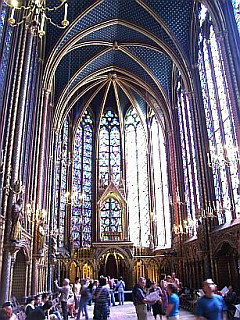
It is located on the island "Ile de la Cité", in the courtyard of the courthouse.
It was built in a Gothic style from 1246 to 1249 at the request of Louis IX (St. Louis) to shelter the crown of thorns of Christ and a fragment of the cross bought from the Emperor of Constantinople. These relics are now present at Our Lady Cathedral.
This chapel is comprised of two floors : the lower chapel for faithful and pilgrims and the upper chapel for the royal family. The upper chapel is entirely surrounded by 15 m (49 feet) high stained glass windows which are also the oldest in Paris. They are separated by thin columns with statues of saints to their base : they give an impression of lightness (high to the sky) with high brightness. It is a marvel and one of the masterpieces of Western churches.
The conciergerie
Also located on the island "Ile de la Cité", it was the former palace of the Capetian dynasty before becoming a prison in the fourteenth century.
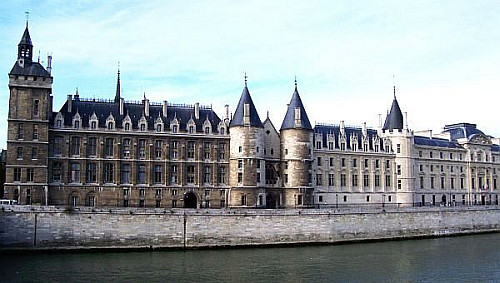
During the French Revolution, it housed more than 2,000 prisoners awaiting execution. Among them : Marie-Antoinette, Danton and St. Just. It can be visited and dummies dressed in revolutionary costumes help recreating the atmosphere of that time.
Saint-Michel square
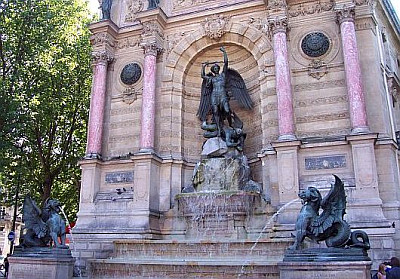
South of the island "Ile de la Cité", this square lies at the foot of a fountain topped by a large statue of St. Michael the Archangel. It is an ideal place for students to set an appointment.
It was also the gathering point for students during the demonstrations of May 1968.
Nearby, we can see many booksellers along the banks of the Seine. It is also the charm of Paris.
Arc de triomphe
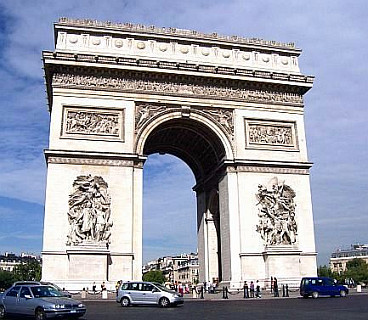
Located on the main Charles de Gaulle square (in fact a roundabout, also known as Place de l'Etoile), the Arc de Triomphe, commissioned by Napoleon Bonaparte in 1806 to celebrate his victories of Marengo and Austerlitz had not been completed until 1836. It has several high-relief ("Marseille", "Triumph"...).
The tomb of the Unknown Soldier of the Great War of 1914-18 (one among many others !) was placed under the arc and a flame of remembrance burns continuously.
The top of the platform is open to the public.
Champs-Elysées avenue

The most largest and legendary avenue in Paris, 1.9 km (1.18 miles) long and more than 70 m (77 yards) wide, is bordered with shops, restaurants and cinemas. It leads to place de l'Etoile (Charles de Gaulle square).
The Elysée Palace, residence of the French President, is on Faubourg Saint-Honoré (a street parallel to the Champs-Elysées).
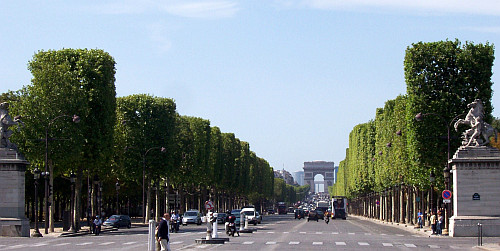
Pont Alexandre III, petit palais and grand palais
Alexandre III bridge, the most beautiful bridge in Paris, is a tribute to the alliance between the Czarist Russia and France in 1892.
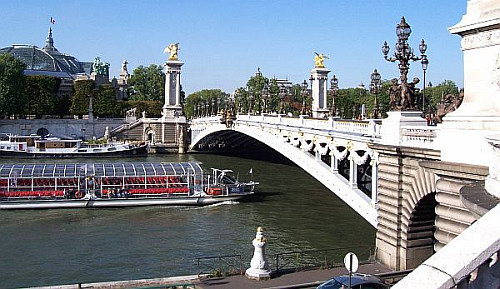
Near "Champs-Elysées-Clemenceau" station, two Baroque palaces were built for the Universal Exposition of 1900 : the petit palais and just in front of it, the grand palais. The first one houses museums and the second one, which has a large glass roof, houses the very interesting Palace of discovery where we can see funny experiences about physics and science (the entrance is located Franklin Roosevelt avenue).
Les Invalides (the Invalids)
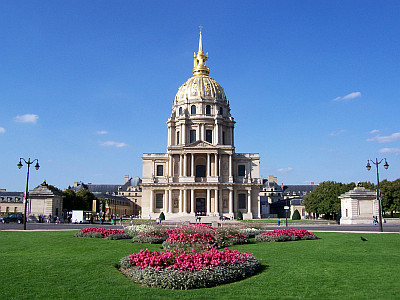
This is a monument built at the request of Louis XIV to be a hospital and to receive the retired, wounded and disabled soldiers.
It now houses the Army Museum, the tomb of Marshal Foch and the monumental tomb of Napoleon Bonaparte, located under the dome (and decorated with gold).
Paris bridges
We could list all of them, but I am just going to talk about my top three : Alexandre III bridge, the most beautiful bridge of the capital (see above), the Alma bridge with its Zouave statue that adorns one of the pillars and is used as an indicator of the level of the Seine, the grenelle bridge near the island "Ile du cygne" on which a replica model of the Statue of Liberty of New York was erected (note : the statue of Liberty in New-York was sculpted by Bartholdi and was a gift from France).
Place de la Concorde (Concorde square)
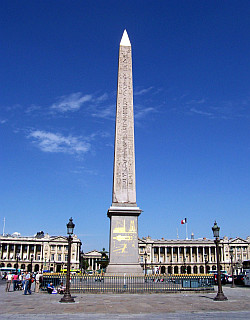
Luxor obelisk, more than 3,000 years, in granite, and covered with hieroglyphics, adorns the Place de la Concorde. The 23 m high obelisk was a gift from the Viceroy of Egypt to France in 1831. She was placed on the square in 1836. The fountains are also worth a look.
Next to it, the building of "jeu de paume" houses the Museum of Contemporary Art and the Museum of orangery which contains Impressionist paintings.
South of the square, we notice the old facade of the Palais Bourbon (Bourbon palace), which is nowadays the National Assembly.
The execution (by guillotine) of Louis XVI, Marie Antoinette and many others took place here during the Revolution...
La Madeleine
St. Mary Magdalene church looks like an ancient temple with Corinthian columns.
Grands boulevards
At the "grands boulevards", drawn under Louis XIV, one can find the stock market but also the Palais Garnier (an opera house) and Grévin museum.
Opéra Garnier
The impressive Opera Garnier, who took the name of its architect, was built in baroque style under Napoleon III.
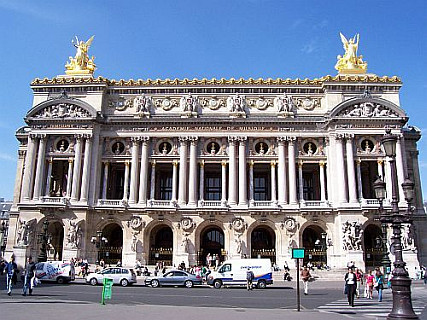
It is technically outdated and major performances are given at the Opera Bastille.
Grévin museum
This interesting museum houses many life-size wax statues of artists and politicians. The result is astonishing as it looks really actual ! There is also a gallery dedicated to the kings of France.
Three major steps are needed to mold the face of an artist :
- Molding of a 3D face in clay.
- Making of a mold from the clay model.
- By molding, achieving of the wax face. Then adding the make up for the skin, a dental prosthesis and eyes made specifically for each character.
Do note that the price is 21 € (in 2011 and full price) !... Have a look at the pictures below and official web site to get more informations : http://www.grevin.com/en
Vendôme square
The large carved column was commissioned by Napoleon to pay tribute to the victories of the Grand Army. It is covered with a cap made of bronze with the cannons taken from the Russian and Austrian armies at the Battle of Austerlitz. It is inspired by the Trajan column in Rome (especially for the decorated frieze).
Rue de la Paix from the square to the north was made famous by the game "Monopoly" (in its French version) as it is the most popular (and expensive) street. And strolling there we can guess why : there are many luxury stores...
Le Louvre
Tuileries and Carrousel gardens
We can access the Louvre going through the Tuileries Gardens (created in 1664), and the Carrousel Gardens. We then find the triumphal arch built in 1806 in tribute to the victories of Napoleon and on top of which stands the quadriga of victory and peace (a copy from the one of St. Mark's basilica in Venice).
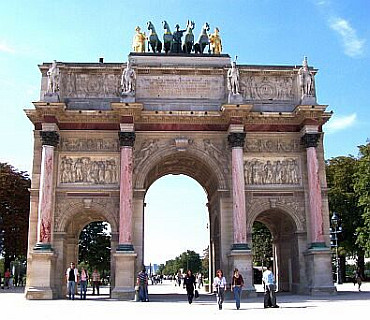
Louvre palace
Built by King Philippe Auguste in 1190 and remodeled in the Renaissance, the Louvre was a royal residence until the removal of the court at Versailles under Louis XIV.
In the central courtyard (Napoléon courtyard) we may be surprised to find the "pyramid of the Louvre", an anachronistic and controversial pyramid composed of glass panels and built in 1981 according to the will of President François Mitterand. It both decorates the entrance of the museum and lets the light come in. In the basement, we can visit the foundation of the old fortifications of the Middle Ages.
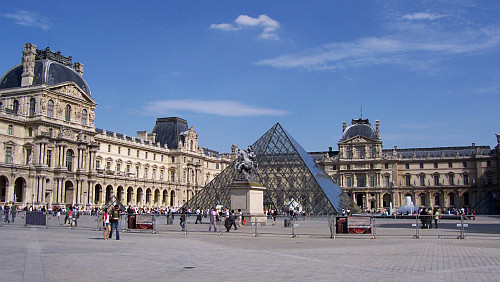
Louvre museum
This is one of the largest museums in the world and it takes at least a full day to see everything (I mean the rooms open to visitors) and one shouldn't loiter ! otherwise, for lovers of the Louvre, two or more days are needed...
The galleries include paintings; sculptures; Greek, Egyptian, Etruscan, Roman and Oriental antiquities. Not to be missed : the painting "Mona Lisa" by Leonardo da Vinci, famous all over the world for the enigmatic smile of Mona Lisa; great paintings such as the "Raft of the Medusa" by Géricault, "Freedom, led by the People" by Eugène Delacroix...; and many other paintings (i.e. "Gilles" by Watteau...); famous sculptures such as the Venus de Milo, the Victory of Samotras and many others !...
Palais Royal (Royal palace)
Near the Louvre, this palace was built by Cardinal Richelieu and belonged again to the royal family after his death. The Ministry of Culture is set in its walls. In the courtyard, no need to say that the Buren columns look anachronistic.
Panthéon
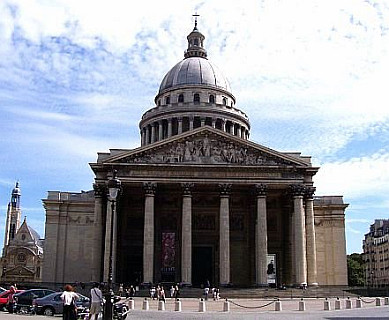
This ancient church dedicated to St. Genevieve was built in the 18th century following a vow of Louis XV. Its neoclassical architecture was inspired by the Pantheon in Rome. The Pantheon of Paris became the mausoleum of the famous French men since the revolution. There are over sixty tombs : Voltaire, Rousseau, Victor Hugo, Zola, Pierre and Marie Curie...
On the pediment is inscribed "to the great men, the grateful homeland".
Foucault's pendulum experiment
In 1851, Leon Foucault performed an experiment to prove the rotation of the earth. He hung at the top of dome a 67 m (220 feet) steel cable with a ball made of lead and covered with a copper jacket, weighing 28 kg (62 pounds). He moved the ball away from the center and released it (so without pulse) and let it swing. He noticed that the ball deflected regularly from its initial rotation axis (11.3° per hour in Paris) : this is the effect of the Coriolis force.
Note :
* the amplitude of oscillation decreases more and more but, as the distance was nearly 3 m (3.3 yards), the movement may take several hours...
* the direction of rotation is reversed in the Southern Hemisphere, and the speed is different depending on latitude.
Near the Pantheon, one can also go to St. Etienne du Mont church.
Luxembourg palace and garden
The Luxembourg Palace was built in the early 17th century for Marie de Medici. Its garden is quite lovely.
There are several statues including one of a Celtic druidess, Velleda, from a book of Chateaubriand. It is unusual as since the Renaissance the statues were representations of the heroes of Greek or Roman mythology. In fact, this statue of the 19th century was inspired by the romanticism of that era who rediscovered the Gaul culture whereas the monarchy refered to the Franks of Clovis.
The palace now houses the Senate.
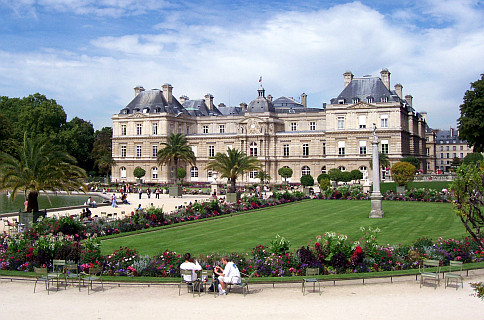
Montparnasse tower
It is the highest tower in France. We can access the top floor (where there is a restaurant) to gaze at a magnificent view over Paris.
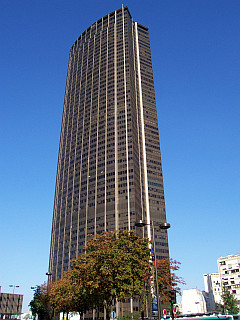
Around the Place du Châtelet (Chatelet square)
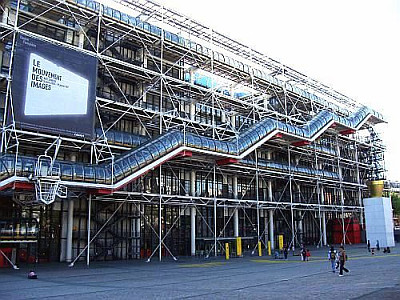
At Châtelet, there are two theaters and the City Hall of Paris built in a Renaissance style.
St. James tower is the only remnant of a church that was a starting point to Santiago de Compostela. A statue of the Saint is also present at the top. In addition, a statue of Pascal is located inside as reminder that this is the place where he began his first experiments on atmospheric pressure.
An underground shopping mall (Forum des Halles) has replaced an old-fashioned marketplace then called the "stomach of Paris".
The Georges Pompidou center, also known as "Beaubourg", was built in 1977 with a contemporary architecture. It houses the Museum of Modern Art (fauvism, surrealism, cubism, abstract art...).
The Stravinsky fountain nearby reinforces the contemporary aspect of the place.
Montmartre and the Sacred Heart
Montmartre is the bohemian district of Paris : living place and convergence point for artists of the last century who found there lower rents than in the rest of the capital.
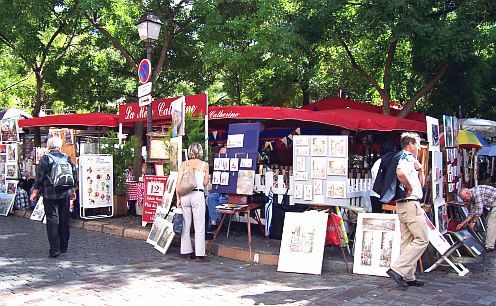
Today, one can have a charcoal portrait drawn by one of the many artists present all around (but beware of prices and ask before : never accept before knowing the price !) and have a coffee at Du Tertre square, always buzzing.
The Basilica of the Sacred Heart was built from 1876 to 1914, a mix of Roman, Byzantine and Classical style, in gratitude for the no destruction of Paris after the defeat of 1870 against the Prussians.
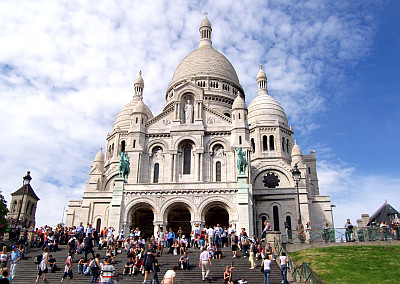
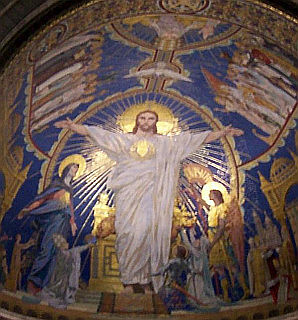
This is my favorite monument in Paris, with of course the Eiffel Tower !
The whiteness of the stone is striking ! The tower contains one of the largest bells in the world called the "Savoyard" as it was offered by the city of Annecy. We can access the top of the ovoid dome to gaze at a beautiful view over Paris. In the church, the mosaic representing the Sacred Heart is superb ! It is also the largest mosaic of France.
In the crypt, there are funeral urns containing the hearts of men to whom we owe the construction of the basilica.
The stairs from St. Peter's Square to the parvis of the basilica are worth seeing. We can take it or go and take the nearby funicular.
The devotion to the Sacred Heart of Jesus began in Paray-le-monial with the apparition of Christ to St. Margaret Mary Alacoque.
Pigalle
At the foot of Montmartre there is Pigalle square, which is the "sex" place in Paris. These are mainly "sex shop" and "Peepshow" which are scams and tourist traps in a murky world.
Fortunately, nothing to do with the famous Parisian cabarets that are : le Moulin Rouge and its "french cancan" (from Offenbach, a German composer naturalized French), le Lido, les Folies-Bergère, le Paradis Latin, le Crazy horse or transformists from Michou...
Bastille square
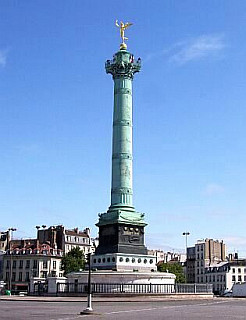
It was on this square that stood the Bastille, a state prison which was stormed by the revolutionary "sans-culottes" in July 14, 1789, marking the beginning of the Republic and announcing the fall of the monarchy. There is nothing left of the old building which was completely destroyed.
In the center of the square, the July column was erected in memory of the victims of the revolution of 1830 (the three glorious). It is surmounted by the Spirit of Freedom.
The Opera Bastille is relatively new as built in 1989.
Marais neighborhood
We can visit the house where Victor Hugo lived along the Place des Vosges. In this square were organized tournaments in the Middle Ages, and this is where King Henry II was fatally wounded in the eye during a game. The area has beautiful mansions.
At night, the Marais neighborhood is more connected with gays and there are gay bars with rainbow flag (rallying the gay, lesbian and transgender community).
Plants garden
There is a park, greenhouses, a menagerie (zoo) with a hall devoted to microscopic organisms, and the great Buffon's natural history museum : not to be missed !
Buffon's Natural history museum
On several floors, there are stuffed animals (mammals, insects...) or reproductions for extinct or underwater species. Many factsheets are at one's disposal. They are to be seen, for young and old, and one can even spend several hours if one want to take notes.
Menagerie
It is a real zoo in the city center with mammals, birds, reptiles and even microscopic insects.
Buttes-Chaumont park
With its lake and its fake Roman temple from where one has a view on the Basilica of the Sacred Heart, it is also a park where one can run.
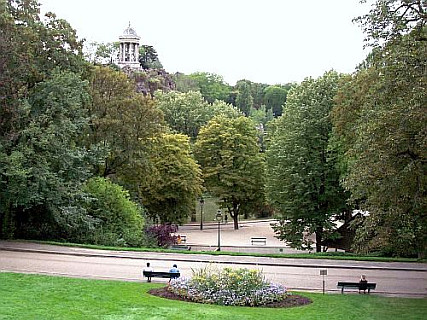
Great cemeteries
These cemeteries are visited for their many graves of famous people.
Père Lachaise cemetery
The oldest cemetery in Paris dates back to 1804. Among the many tombs and other mausoleums, there are the graves of : La Fontaine, Molière, Balzac, Delacroix, Champollion, Chopin, Daudet, Petrucciani, Edith Piaf, Proust, Rossini, Oscar Wilde, Yves Montand, Simone Signoret, Jim Morrison... (their graves are not necessarily the most prestigious. I think especially of La Fontaine and Molière for whom I had expected a better posthumous tribute).
Among the tombs the most viewed there is the one of Oscar Wilde (we can see its polychrome statue in Dublin) and especially the one of Jim Morrison, still flowered.
To be seen in the gallery some of the graves of personalities : Champollion, Balzac, Oscar Wilde...
One wall is called "Wall of the Federals" (aka Wall of the Communards) : it is the place where a group of communards fell under the bullets of the troops of Thiers who came and took back the capital in 1871.
Beside, link to the official website of Père Lachaise :
http://www.pere-lachaise.com/perelachaise.php?lang=en
Montparnasse cemetery
Opened in 1824, the Montparnasse cemetery also has graves of several celebrities including : Maupassant, Baudelaire, Captain Alfred Dreyfus...
Montmartre cemetery
Here is another cemetery located north of Paris...
Orsay museum
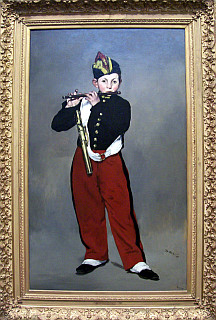
The great impressionist art museum (paintings, sculptures) is located in the former Orsay railway station that has been saved from the destruction planned in the '60s.
We can see for instance : "luncheon on the grass" by Manet (it was an outrage at that time), the "fifer" by Manet, "poppies" by Monet, "self portrait" by Van Gogh, "Hercules" by Emile-Antoine Bourdelle, "Polar Bear" by Pompon, as well as works by Renoir, Gauguin, Toulouse-Lautrec, Cezanne, Rodin (his sculptures)...
A part is also dedicated to art nouveau.
City of Science and Industry at La Villette
The City of Science and Industry at La Villette was built on the site of the an slaughterhouse. We discover laws and experiences in mathematics, biology, computer science, aeronautics, aerospace...
Outside the main building, the geode is a large sphere with a 36 m (39 yards) diameter where IMAX "Image MAXimum" movies are projected on hemispherical screen (a technique also used in the Futuroscope in Poitiers). These movies and can be in 3D.
Denfert-Rochereau and the catacombs
At Denfert-Rochereau, we can not miss the great statue of the lion, a copper replica of the Lion of Belfort.
Nearby, we can access an entry of the "catacombs" or rather the municipal ossuary : dug in 1786, they were used to keep the bones of the dead and empty and cemeteries. See the official website http://www.catacombes-de-paris.fr/english.htm
Beaware : not recommended for claustrophobic and sensitive people, as we go through many piles of bones and skulls...
Rue du bac
Paris is a Marian city : it is in 1830 in the chapel of Rue du Bac (n. 140) that the Sister Catherine Laboure received Apparitions of the Virgin who asked her to transmit a oval medal known as the miraculous medal. On the obverse, the prayer "O Mary, conceived without sin, pray for us who have recourse to thee" and on the back : the M of Mary surmounted by the cross, the two hearts (the one of Jesus with the crown of thorns and the one of Mary pierced by the sword) with the whole surrounded by twelve stars.
The body of St. Catherine Laboure is kept in the Chapel of the Apparitions which is a Christian pilgrimage.
La Défense
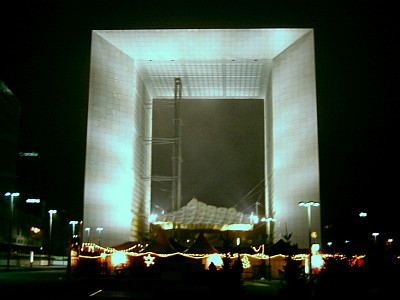
The business district of La Défense was built to house offices and administrations. Its name, "La Défense", was given after the siege of the capital by the Prussians in 1871 (as "défense" means defense). The glass and steel towers and skyscrapers give it a US look.
The ark was built of glass and white marble in 1989. It became at once the symbol of the business district.
More visits in Paris
-
Latin Quarter : it was the students district who still spoke Latin in the Middle Ages. In this area, there is the University of Sorbonne : a nerve center of student protests.
-
Saint-Germain-des-Prés, where the oldest church of Paris houses the tombs of Descartes and of a king of Poland. The boulevards were laid out by Baron Haussmann under Napoleon III who wanted to make the streets more accessible in order to reduce the risk of barricades.
-
Saint-Germain church, near Chatelet (not to be confused with the previous one).
-
The remains of the Arena of Lutece.
-
The National library, also known as François Mitterand library, or "great library". Each one of the four towers is built at right angle to let people think of an open book.
-
Bercy : omnisport palace ("grass covered pyramid") and the American Center. The ministry of finance is also at Bercy.
-
Monceau park, Montsouris park.
-
André Citroën park (15th district), Albert Kahn park (Boulogne-Billancourt).
-
The headquarters of the UNESCO.
-
Sewers, for those who are interested... after all, Jean Valjean, the hero of Victor Hugo, has taken them :-). The entrance for visits is at 93 Quai d'Orsay.
-
The castle of Vincennes, built in the 14th century by Charles V. De Gaulle had thought to install the Presidency of the Republic here rather than in the Elysee Palace. Today the castle houses the history department of defense.
-
Vincennes wood, with its racecourse, its floral park (performances are given in summer) and zoo (on borrowed time while writting these lines).
-
Boulogne wood, with the jardin d'Acclimatation (an amusement park) and Bagatelle park. But to be avoided at night because it becomes a place of prostitution of transsexuals and transvestites...
-
Golden statue of Joan of Arc in "place des pyramides" (pyramids square).
-
Equestrian statue of Henri IV in "square Vert-Galant".
-
Statue of Louis XIV in "place des victoires" (victories square).
-
Air and space museum at Le Bourget (north of Paris).
-
Museum of Arts and Crafts. Here are some examples of what we can see : the Pascaline, the abacus, 3D reproductions of geometric shapes such as the parabolic hyperboloid, construction methods, one of the first cyclotron (particle accelerator), the first generation of computers, how a hard disk operates, the phonograph (which works by sound vibrations), many different gears, bearings, materials, coils, robots, the laboratory of Lavoisier and more... without forgetting Foucault pendulum's experiment.
-
Many other museums.
-
The secular nursery of Père-Lachaise at 3 Martin Nadaud square, with its facade imitating wood, is staggering in the heart of Paris... There is a house of the same type in Vésinet : the wood cottage.
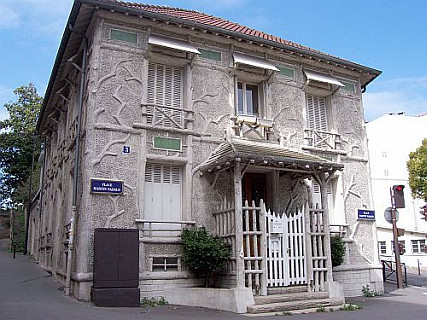
-
And a lot more (for town planning fan there is the building named "Grand Pavois" of Paris in the 15th district)...
